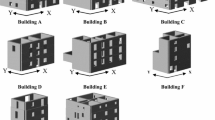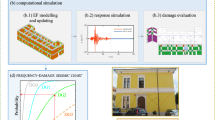Abstract
The paper presents a new simplified mathematical model for predicting the structural seismic response of buildings. The model, denominated Seismic Model from Ambient Vibrations (SMAV), is based on the experimental modal parameters identified from ambient vibration and only a few information about the geometry and the structural typology of the building. After a short review of the Multi Rigid Polygons model, recently illustrated and validated in an other paper by some of the authors, that allows to estimate the seismic participation factors of the experimental modes also for buildings characterized by complex shaped plan and structural irregularity along the height, the attention is focused on a new stochastic approach for modeling the seismic response of masonry buildings. In particular this new approach aims to take into account the non linearity occurred during a seismic event so that the nonlinear behaviour of the building is considered by reducing its modal frequencies according to the response amplitude. The reduction of the natural frequencies, extracted by Operational Modal Analysis from ambient vibrations, is computed according to specific probabilistic curves: the Frequency Shift Curves (FSCs). This curves provide the percentage reduction of the natural frequencies as a function of the maximum roof drift reached during the strong motion and they are obtained, for some specific masonry typologies, through a Monte Carlo analysis carried out using a simple mechanical model of a masonry panel with geometric and mechanical parameters that vary according to their probabilistic distributions. The seismic response of the building is then computed through a linear equivalent analysis in which an iterative algorithm updates the resonant frequencies according to the specific FSC curve. The concept of structural serviceability index (IOPS), expressing the probability of the building to remain operational, is also introduced. Finally, a comparison between the seismic response computed by the model and the experimental seismic response of the Pizzoli town hall, a masonry existing building endowed with a permanent accelerometer monitoring system, is illustrated.










Similar content being viewed by others
Abbreviations
- \(\varvec{f}\) :
-
Vector of natural frequencies
- \({\varvec{\Phi}}\) :
-
Matrix of mass scaled mode shapes
- \(\varvec{\xi}\) :
-
Vector of modal damping ratios
- \(k\) :
-
Subscrit denoting that the quantity refers to the k-th mode
- \(\varvec{M}\) :
-
Mass matrix of the Multi Rigid Polygon (MRP) model
- \(\varvec{D}\) :
-
Matrix of the linear transformation from phisical to MRP degree of freedom
- \(\bar{\varPsi }\) :
-
Matrix of the mode shapes of the MRP model
- \({\varvec{\Gamma}}\) :
-
Vector of modal participation factors
- T :
-
Time
- \({\mathbf{\ddot{u}}}_{g} \left( t \right)\) :
-
Acceleration time history on the ground
- \(\varvec{u}\left( t \right)\) :
-
Vector of the dinamic displacements of the structure
- \(T\) :
-
Structural period
- \(S_{\varvec{a}} \left( T \right)\) :
-
Pseudo-acceleration response spectrum of the seismic input at \(T\)
- \(S_{\varvec{d}} \left( T \right)\) :
-
Displacement response spectrum at \(T\)
- \(\delta\) :
-
Roof drift
- \(\delta_{y}\) :
-
Yeld roof drift
- \(\delta_{m}\) :
-
Maximum roof drift
- \(MIDR\) :
-
Maximum Interstory Drift Ratio
- \(\varvec{q}\) :
-
Vector of geometrical and mechanical parameters which characterize the wall panel
- \(\rho_{f} (\delta ;\, \varvec{q} )\) :
-
Frequency Shift Curve (FSC)
- \(F(\delta )\) :
-
Force-drift relationship associated to this assumed mechanical model
References
Acunzo G, Fiorini N, Mori F, Spina D (2015) VaSCO-smav: the software developed for the SMAV methodology application (in italian). In: XVI Conference of Italian national association of earthquake engineering (ANIDIS)
Acunzo G, Fiorini N, Mori F, Spina D (2018) Modal mass estimation from ambient vibrations measurement: a method for civil buildings. Mech Syst Signal Process 98C:580–593
Bodin P, Vidale J, Walsh T, Cakir R, Celebi M (2012) Transient and long-term changes in seismic response of the natural resource building, Olympia, Washington, due to earthquake shaking. J Earthq Eng 16:607–622
Calvi GM, Pinho R, Magenes G, Bommer JJ, Restrepo-Velez LF, Crowley H (2006) Development of seismic vulnerability assessment methodologies over the past 30 years. ISET J Earthq Technol 43(3):75–104
Celebi M (2007) On the variation of fundamental frequency (period) of an undamaged building—a continuing discussion. In: Proceedings of the conference on experimental vibration analysis for civil engineering structures (EVACES’07) Porto, Portugal, Oct 24–26, pp 317–326
Ceravolo R, Matta E, Quattrone A, Zanotti Fragonara L (2017) Amplitude dependence of equivalent modal parameters in monitored buildings during earthquake swarms. Earthq Eng Struct Dyn. https://doi.org/10.1002/eqe.2910
Clinton J (2006) The observed wander of the natural frequencies in a structure. Bull Seismol Soc Am 96:237–257
Dolce M, Masi A, Marino M, Vona M (2003) Earthquake damage scenarios of the building stock of Potenza (Southern Italy) including site effects. Bull Earthq Eng 1(1):115–140
Dolce M, Nicoletti M, De Sortis A, Marchesini S, Spina D, Talanas F (2017) Osservatorio sismico delle strutture: the Italian structural seismic monitoring network. Bull Earthq Eng 15:621–641
Dong A, Tiejun Q, Jianwen L (2013) Seismic behavior of two-story brick masonry building. Appl Mech Mater Trans Tech Publications, Switzerland 275–277:1456–1460
Flores LE, Alcocer SM (1996) Calculated response of confined masonry structures. In: Eleventh world conference on earthquake engineering
Lagomarsino S, Cattari S (2013) Seismic vulnerability of existing buildings. In: Guéguen P (ed) Seismic vulnerability of structures. Wiley, Croydon, pp 1–62
Lagomarsino S, Penna A, Galasco A, Cattari S (2013) TREMURI program: an equivalent frame model for nonlinear seismic analysis masonry buildings. Eng Struct 56:1787–1799
Ljung L (1987) System Identification: Theory for the user. Prentice Hall PTR, Upper Saddle River, pp 71–81
Magenes G, Calvi GM (1997) In-plane seismic response of brick masonry walls. Earthq Eng Struct Dyn 26:1091–1112
Magenes G, Morandi P, Penna A (2008) Test results on the behaviour of masonry under static cyclic in plane lateral loads, ESECMaSE project, report RS-01/08. Department of Structural Mechanics, University of Pavia, Pavia
Michel C, Guéguen P (2013) Experimental Method. In: Guéguen P (ed) Seismic vulnerability of structures. Wiley, Croydon, pp 161–212
Michel C, Guéguen P, Bard PY (2008) Dynamic parameters of structures extracted from ambient vibration measurements: an aid for the seismic vulnerability assessment of existing buildings in moderate seismic hazard regions. Soil Dyn Earthq Eng 28:593–604
Michel C, Guéguen P, El Arem S, Mazars J, Kotronis P (2010) Full-scale dynamic response of an RC building under weak seismic motions using earthquake recordings, ambient vibrations and modeling. Earthq Eng Struct Dyn 39:419–441
Michel C, Zapico B, Lestuzzi P, Molina FJ, Weber F (2011) Quantification of fundamental frequency drop for unreinforced masonry buildings from dynamic tests. Earthq Eng Struct Dyn 40(11):1283–1296
Mori F, Spina D (2015) Vulnerability assessment of buildings based on ambient vibrations measurements. Struct Monit Maint 2(2):115–132
Mottershead JE, Link M, Friswell MI (2011) The sensitivity method in finite element model updating: a tutorial. Mech Syst Signal Process 25(7):2275–2296
Peeters B, De Roeck G (2011) Stochastic system identification for operational modal analysis: a review. J Dyn Syst Meas Control 123:659–667
Ranieri C, Fabbrocino G (2014) Operational modal analysis of civil engineering structures: an introduction and guide for applications. Springer, Berlin
Reynders E (2012) System identification methods for (operational) modal analysis: review and comparison. Archives Comput Methods Eng 19:51–124
Shing PB, Noland JL, Klamerus E, Spaeh H (1989) Inelastic behavior of concrete masonry shear walls. J Struct Eng 115(9):2204–2225
Spina D, Lamonaca BG (1998) Strengthening assessment of building using ambient vibration tests. In: Proceeding of XI conference on earthquake engineering, Rotterdam, Balkema
Spina D, Lamonaca BG, Nicoletti M, Dolce M (2011) Structural monitoring by Italian department of civil protection and the case of 2009 Abruzzo seismic sequence. Bull Earthq Eng 9:325–346
Todorovska M (2009) Seismic interferometry of a soil structure interaction model with coupled horizontal and rocking response. Bull Seismological Soc Am 99:611–625
Tomažević M (1999) Earthquake-resistant design of masonry buildings. Imperial College Press, London
Tomažević M, Lutman M, Petković L (1996) Seismic behavior of masonry walls: experimental simulations. J Struct Eng 122(9):1040–1047
Vasconcelos G, Lourenço PB (2009) In-plane experimental behaviour of stone masonry wall under cyclic loading. J Struct Eng 135:1269–1277
Villaverde R (2007) Methods to assess th seismic collapse capacity of building structures: state of the art. J Struct Eng 133(1):57
Author information
Authors and Affiliations
Corresponding author
Rights and permissions
About this article
Cite this article
Spina, D., Acunzo, G., Fiorini, N. et al. A probabilistic simplified seismic model of masonry buildings based on ambient vibrations. Bull Earthquake Eng 17, 985–1007 (2019). https://doi.org/10.1007/s10518-018-0481-y
Received:
Accepted:
Published:
Issue Date:
DOI: https://doi.org/10.1007/s10518-018-0481-y




